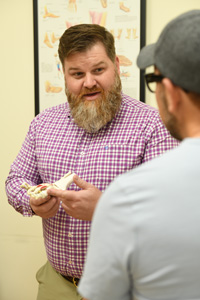Ingrown Toenails
![]() If you trim your toenails too short, particularly on the sides of your big toes, you may set the stage for an ingrown toenail. When a toenail is ingrown, it is curved and grows into the skin, usually at the nail borders. This “digging in” of the nail irritates the skin, often creating pain, redness, and swelling in the toe.
If you trim your toenails too short, particularly on the sides of your big toes, you may set the stage for an ingrown toenail. When a toenail is ingrown, it is curved and grows into the skin, usually at the nail borders. This “digging in” of the nail irritates the skin, often creating pain, redness, and swelling in the toe.
If an ingrown nail causes a break in the skin, bacteria may enter and cause an infection in the area, which is often marked by drainage and a foul odor. However, even if the toe isn’t painful, red, or swollen, a nail that curves downward into the skin can progress to an infection.
Symptoms
When you first have an ingrown toenail, it may be hard, swollen and tender. Later, it may get red and infected, and feel very sore. You may see pus drain from it. Finally, your skin may start to grow over the ingrown toenail.
Causes
Causes of ingrown toenails include:
- Heredity: In some people, the tendency for ingrown toenails is inherited.
- Trauma: An ingrown toenail can be the result of trauma, such as stubbing your toe, having an object fall on your toe, or engaging in activities that involve repeated pressure on the toes, such as kicking or running.
- Improper Trimming: The most common cause of ingrown toenails is cutting the toenails too short. This encourages the skin next to the nail to fold over the nail.
- Improperly Sized Footwear: Ingrown toenails can also result from wearing socks and shoes that are tight or short.
- Nail Conditions: Ingrown toenails can be caused by nail problems, such as fungal infections or losing a nail due to trauma.
Treatment Options
Ingrown toenails should be treated as soon as they are recognized. If it is recognized early, home care may prevent the need for further treatment. However, home treatment is strongly discouraged if an infection is suspected or for those who have medical conditions that put feet at high risk, such as diabetes, nerve damage in the foot, or poor circulation.
Homecare treatments include:
- Soak the foot in warm water 3-4 times daily. Keep the foot dry during the rest of the day.
- Wear comfortable shoes with adequate room for the toes. Consider wearing sandals until the condition clears up.
- You may take ibuprofen or acetaminophen for pain relief.
- If there is no improvement in 2-3 days, or if the condition worsens, call your doctor.
If excessive inflammation, swelling, pain and discharge are present, the toenail is probably infected and should be treated by your Celebration Orthopaedics foot and ankle specialist. You may need to take oral antibiotics and the nail may need to be partially or completely removed. The doctor can surgically remove a portion of the nail, a portion of the underlying nail bed, some of the adjacent soft tissues and even a part of the growth center.
Surgery is effective in eliminating the nail edge from growing inward and cutting into the fleshy folds as the toenail grows forward. Permanent removal of the nail may be advised for children with chronic, recurrent infected ingrown toenails.
Recovery
Following the nail procedure, a light bandage will be applied. Most patients experience very little pain after surgery and may resume normal activity the next day. If your Celebration Orthopaedics surgeon has prescribed an oral antibiotic, be sure to take all the medication, even if your symptoms have improved.
